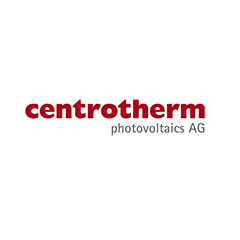- Low-pressure diffusion creates precondition for industrial manufacturing of high-quality emitters
- Highly-efficient bifacial n-type silicon solar cells in mass production
- PECVD process for aluminum oxide coating
Blaubeuren, May 13, 2014 – Both continued cost pressure and the necessity for efficiency improvements will comprise the main topics at next week’s SNEC PV Power Expo trade fair in Shanghai. Here, centrotherm will be presenting its solutions that offer solar cell manufacturers expedient options to reduce their production costs as well as boosting process flexibility for tomorrow’s cell and production concepts.
Convincing results with centrotherm low-pressure phosphorus diffusion
With its highly productive low-pressure diffusion system, centrotherm is enabling its customers to attain cost savings of up to 40 % per wafer. This is achieved through almost doubled system throughput of more than 140 MW per year and lower media consumption. Even in the case of emitter resistances of up to 150 Ω/square, customers achieve outstanding homogeneity, and can fully exploit efficiency potentials of both conventional and new metallization pastes (emitter resistance > 100 Ω/square). The centrotherm low-pressure technology opens up a broad corridor for new diffusion processes for solar cell manufacturers, especially through the fast and changing deployment of gases in the process tube. Currently, centrotherm low-pressure diffusion systems are already installed in mass production with a total capacity of more than 1.2 gigawatts (GW).
Low-pressure boron diffusion
In a joint project with the International Solar Energy Research Center (ISC) in Constance, centrotherm is developing a new low-pressure process for highly efficient boron doping. This enables efficiency enhancement and production cost reduction for n-type solar cells, especially through the integration of upstream and downstream process steps and shorter process times.
New cell concepts for mass production: “BiSoN Alliance” with ISC Constance for bifacial n-type solar cells
Together with ISC Constance and SIBCO, centrotherm is offering process and system packages for the mass production of bifacial n-type silicon solar cells that achieve efficiencies of over 20.5 %. All of the processes required for this have been tested in mass production and developed on centrotherm production systems. These cells are optimally designed and compatible for standard solar module manufacturing. The integration of the BiSoN cell concept into existing mass manufacturing is possible due to the deployment of proven centrotherm production systems entailing low investment and time expense.
Compared with p-type silicon solar cells, n-type cells possess greater efficiency potential and do not exhibit light-induced degradation. The International Technology Roadmap for Photovoltaic (ITRPV) sees their efficiency rising to over 24 % over the next ten years (p-type mono-Si cells only up to 22 %). According to the ITRPV Roadmap which was published in May 2014, the share of n-type silicon solar cells will also continue to report strong growth from below 10 % today to around 40 % over the coming decade.
centrotherm PECVD process for aluminum oxide coating (Al2O3)
Supplementing its centaurus PERC technology to manufacture mono-crystalline solar cells, centrotherm will also offer a further process and system package for passivation with Al2O3/SiNX stacks in the future. Cell efficiencies can be boosted considerably through avoiding recombination losses and increasing reflectivity on the cell rear side.Upgrade packages for centrotherm PECVD systems will be available for our customers during the second half of 2014. New systems can be ordered from 2015.
“We regard ourselves as a solutions-provider to the photovoltaic industry. Our customers’ requirements vary greatly. Our evolutionary approach guarantees our customers that centrotherm systems deployed in their production can be upgraded to the latest state-of-the-art with process and hardware upgrade packages from our technicians, or that new cell concepts such as centaurus (PERC) or BiSoN (n-type) can be integrated into existing and new production lines. Along with our systems’ performance, this is a critical factor for our customers’ investments that also offers additional security and flexibility for the future,” notes Dr. Josef Haase, Senior Vice President Technology Photovoltaics, before adding: “With a track record of more than 2,000 installed systems and the construction of more than 50 turnkey production lines, centrotherm has the world’s largest installed base of PV systems in operation. In addition, most leading producers’ production lines are constructed according to our established manufacturing concept.”













